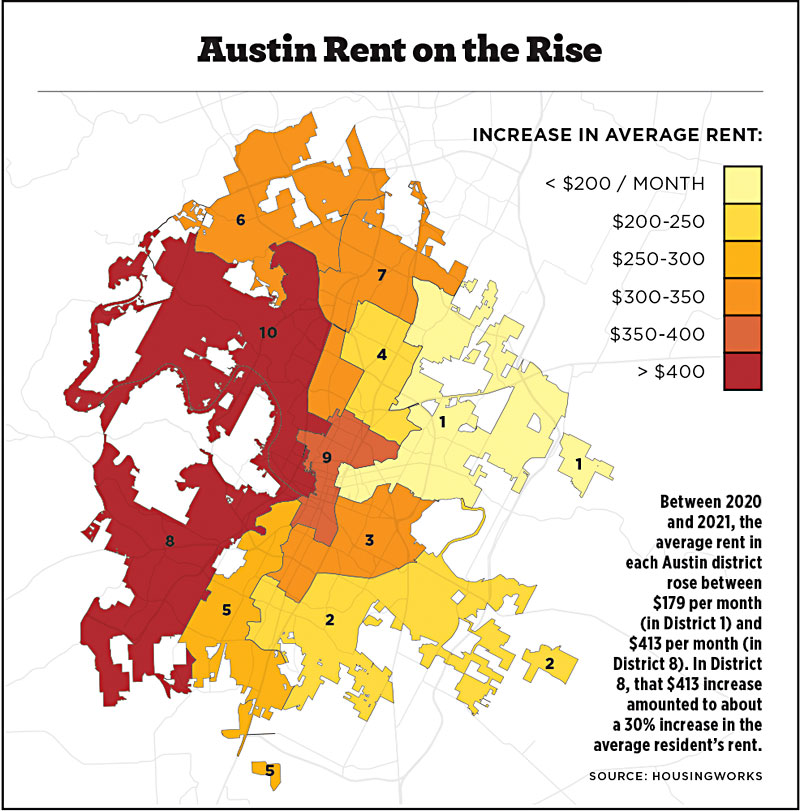City Council to Tweak Compatibility Rules Amid Housing Crisis
Can a change help stem rising housing and rent costs?
By Austin Sanders, Fri., June 10, 2022
How shall we quantify Austin's historic housing crisis today, readers?
It's bad, folks. The Austin Board of Realtors reports that in April, the median sale price for a home in the city of Austin increased by 16.3%, year over year, to $640,000 – yet another record-breaking high for the city. Redfin reported in March that the five-county metro area had experienced a 40% increase in average rents, also year over year; the average throughout the rest of the nation was about 15%.
On cue, Austin-based HousingWorks, which has monitored the city's progress toward meeting the goals in the Strategic Housing Blueprint adopted by City Council in 2017, released its latest analysis of housing production both citywide and in each of the 10 council districts. If you make less than Austin's median family income (which is just over $69,000 for one person, $98,900 for a family of four) your only housing options in the future within the city limits will be in the Eastern Crescent (Districts 2 and 4, and the nongentrified parts of Districts 1 and 3). Or possibly you'll live in the center-city District 9, which has lots of subsidized housing in West Campus and the 1,200 or so homes at Mueller reserved for below-MFI renters and buyers. Those five districts are on track to meet or exceed their Blueprint targets, but the western half of the city (Districts 5, 6, 7, 8, and 10) lags behind those goals by thousands of units.
In terms of total housing production, the Blueprint called for 135,197 new housing units by 2027, about 90,000 of which would be affordable to households at 120% MFI or less. According to data from the Texas Real Estate Research Center at Texas A&M, throughout all of Travis County, over 100,000 building permits had been issued for various residential uses between 2017 and 2021. About 60% of those permits were for properties with five or more dwelling units, roughly 40% were for single-family uses, and less than a paltry 1% were for 2- to 4-unit projects.
On the City Council agenda today, June 9, are two similar but distinct initiatives to amend the Land Development Code. One would reduce parking requirements and the compatibility standards that control building size near single-family housing, but just for properties along specific identified transit corridors. The other would create a new zoning category, vertical mixed-use 2 (or "V2" for short), which would allow up to 90 feet of height and reduce the compatibility buffer (the distance to the nearest single-family home) to 100 feet from the current 470 feet.
The latter (Item 80 on today's agenda) represents the culmination of staff work initiated by Council back in November 2021, when Council Member Ann Kitchen introduced the V2 concept as a way to allow developers extra height (above the 60 feet allowed in current VMU zoning) to, among other things, accommodate ground-floor retail. Throughout the V2 process, Kitchen has pitched the new zoning category as a modest update of an already successful density bonus program that's brought affordable units to places like Burnet Road and East Riverside.
However, at the Council Housing and Planning Committee's meeting May 31, planner Sam Tedford said that since VMU was enacted in 2010, only about one-third of the new development on VMU parcels has actually taken part in the bonus program. Staff analysis also found that, due to compatibility standards, fewer than half of the sites currently zoned VMU can actually be built up to 60 feet; only about 34% could be built up to 90 feet.
Enter the newest face on the dais, CM Chito Vela, who proposed narrow V2 amendments to apply to properties along Project Connect's Orange and Blue light rail lines (North Lamar and Guadalupe on one side of Downtown, South Congress and East Riverside on the other side). Properties along these corridors would only face height restrictions if within 100 feet of a single-family home (instead of the current 540); likewise, they would only have to build 25% of the parking required. Other master plans for these areas (such as the East Riverside Corridor Regulating Plan and Hyde Park's Neighborhood Conservation Combining District) would take precedence if they conflict with these standards.
Though Vela's amendments may be tailored, staff's analysis shows they could have a profound effect on how much housing is produced along the rail lines, where everyone on all sides of the land use debate says they support density. As reported in a June 3 staff memo, a 100-foot buffer would mean that 81% of VMU parcels could be built up to 60 feet, and 73% could reach 90 feet. As we reported last week in "Public Notice," Kitchen has welcomed Vela's amendment, but in her latest version of V2 she's also boosted the on-site affordability requirements that make properties eligible for the bonus, to either 15% of rental units affordable at 60% MFI or 12% affordable at 50% MFI. (Staff had recommended 12% and 10%.) Precisely calibrating affordability requirements is a tricky balancing act; they need to be stringent enough to meet Austin's enormous needs without being so strict that developers cannot finance their projects and thus end up opting out of the bonus program.
Then there's the second proposal. In April, Vela proposed completely exempting VMU properties from compatibility and parking requirements, which would make 90% of VMU parcels buildable to 90 feet in height. But in the background, Mayor Steve Adler and Mayor Pro Tem Alison Alter were working out a compromise – also on the June 9 agenda as Item 66 – that effectively killed Vela's idea. Adler and Alter (along with CMs Vanessa Fuentes, Leslie Pool, and Paige Ellis) proposed slight relaxations of compatibility standards along specific corridors defined as "larger" (Project Connect corridors, highways, perhaps existing transit-friendly infill projects) and "medium" (corridors identified in the Imagine Austin Comprehensive Plan or the 2016 Mobility Bond, such as 45th Street, Brodie Lane, and Metric Boulevard). The Adler/Alter proposal would allow parcels on these corridors to be built to 65 or 90 feet at various distances from the homes casting the compatibility spell, up to where it loses its effect at 300 feet away. On large corridors, these projects could build only 25% of the parking otherwise required; properties on medium corridors would get a 50% reduction in parking. Neither of these reductions would apply within 300 feet of a school.
All of these tweaks and twists would only produce more housing on corridors that, even with the Orange and Blue lines in place, will have high vehicle traffic, more auto-pedestrian crashes, and more asthma and other health effects from vehicle emissions. Building housing within the neighborhoods between these corridors is politically impossible most of the time. Staff has recommended Council consider other LDC changes that could help, like smaller lot sizes and by-right construction of accessory dwelling units, but those ideas will have to be fought over in the future, perhaps by a new council.
Got something to say? The Chronicle welcomes opinion pieces on any topic from the community. Submit yours now at austinchronicle.com/opinion.







